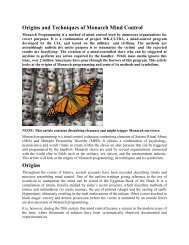7dmGW2vqk
7dmGW2vqk
7dmGW2vqk
You also want an ePaper? Increase the reach of your titles
YUMPU automatically turns print PDFs into web optimized ePapers that Google loves.
Chapter I<br />
operations during deployment are unopposed and the host country is supporting the<br />
deployment.<br />
(2) Uncertain Environment. An uncertain environment is an OE in which HN<br />
forces, whether opposed to or receptive to operations that a unit intends to conduct, do not<br />
have totally effective control of the territory and population in the intended OA. In this<br />
situation, entry operations during deployment are generally unopposed but could be opposed<br />
at any point during the deployment by forces or individuals not under HN control.<br />
(3) Hostile Environment. A hostile environment is an OE in which hostile forces<br />
have control as well as the intent and capability to effectively oppose or react to the<br />
operations that a unit intends to conduct. In this situation, the deploying force must conduct<br />
forcible entry operations to secure a lodgment for reception of the joint force to provide for<br />
the continuous landing of forces and materiel and provide space for subsequent operations,<br />
such as onward movement and integration. Should US forces be denied temporary physical<br />
access to a specific geographic location, the JFC should plan forcible entry operations from<br />
an existing forward operating site or consider the use/formation of an intermediate staging<br />
base (ISB) near the objective area or forward deployed maritime forces.<br />
2. Global Force Management and Force Projection<br />
a. Global Force Management (GFM). At any given time there could be multiple<br />
requirements to employ military forces. Each operation could have a different strategic<br />
priority and could be of a different size and scope. To effectively support multiple<br />
requirements, and apply the right level of priority and resources to each, requires effective<br />
GFM. The GFM and the Adaptive Planning and Execution (APEX) processes have separate<br />
and distinct purposes but are interdependent by design, with APEX focusing on designing,<br />
organizing, and executing operations to create desired effects and GFM focusing on<br />
identifying, providing, and managing the forces and capabilities needed to support those<br />
operations. GFM aligns force assignment, apportionment, and allocation methodologies in<br />
support of the National Defense Strategy, joint force availability requirements, and joint<br />
force assessments. It provides comprehensive oversights into the global availability of US<br />
military forces/capabilities and provides decision makers a process to quickly and accurately<br />
assess the impact and risk of proposed changes in forces/capability assignment,<br />
apportionment, and allocation.<br />
(1) The GFM process cycle starts and ends with the Secretary of Defense (SecDef).<br />
In accordance with (IAW) Title 10, United States Code, SecDef assigns and allocates<br />
forces/capabilities, provides planning guidance to combatant commands (CCMDs), and<br />
provides overarching strategic guidance to the Chairman of the Joint Chiefs of Staff (CJCS).<br />
The CJCS apportions forces/capabilities to CCMDs for adaptive planning and develops<br />
strategic-level guidance. CCMDs, in turn, coordinate force/capability requirements with the<br />
CJCS or delegated CCDR based on SecDef’s guidance across the three processes; develop<br />
Guidance for Employment of the Force (GEF)-directed plans with forces apportioned by the<br />
CJCS, and forward designated plans to SecDef for approval.<br />
I-2 JP 3-35







